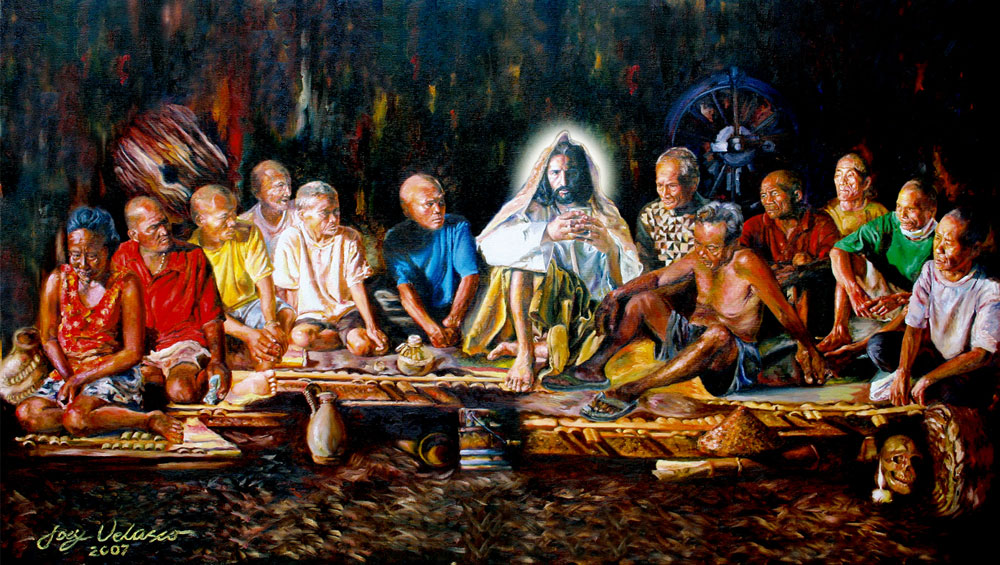Listen to this Sunday’s preaching by Ptr Joseph Tiu SanJose.
Reading: Acts 2:44-47
All the believers were together and had everything in common. They sold property and possessions to give to anyone who had need. Every day they continued to meet together in the temple courts. They broke bread in their homes and ate together with glad and sincere hearts, praising God and enjoying the favor of all the people. And the Lord added to their number daily those who were being saved.
Last week’s preaching was about having a place at the table. Who is at the table and where? Pointing also and much consideration to those who are under the table, receiving crumbs. Just like the Jeepney and my New Testament professor’s Jeepney hermeneutics, as Filipinos, how do we make one more space, one more seat for someone in the table? How do make the table bigger to accommodate one or several others more. That was the preaching last week.
Today let me preach about what is in the table. After all why come to the table if not for what is in the table, right? Though certainly, depending on which culture you come from or which culture you go to, tables may be different or perhaps tables are not necessary. Certainly, many people even from our own country are not able to afford having a table just to eat on. In many instances, it wouldn’t fit into their home under the bridge, by the creek or on some area of the Manila Bay, Bacoor or Navotas area. Sometimes, the table is the floor itself. But that is another story for another time.
We don’t need to imagine the table actually because we have ONE Big table right here. We speak of table or Hapag in the Asian and Filipino imagination, what first comes into mind is eating. Of course there are other types of tables and uses for it. But in our context and for today’s preaching, we are limited to the table where we gather to eat. An image of a traditional family eating dinner. Many of our own commercials in television showcase family dinners where Jollibee, KFC or lucky-me noodles are the main attraction. So, let us talk about food. We speak of a place in the table but what is in the table worth coming to?
First century Christians, both Jews and non-jews were not so different from us Filipinos. They gathered around the table, families, friends and on some feast days, there would be larger gatherings as they are able. This is particularly true because first and second generation Christians were mostly peasant poor. In order for them to actually eat and survive, as we read, they had to come together in a community to share and distribute so that everyone will have enough. What would possibly be in their tables when they came for agape dinner? What sort of dishes where brought and served?
In the Jesuit spirituality, there is a spiritual practice where it will ask us to imagine ourselves sitting at the table of first century Christians and imagine ourselves being there. What would we find in the table where Peter, John, Mary Magdalene, Mary mother of Jesus, and his sisters and brothers sat? What sort of smells would we smell?
Now, that’s kinda hard as we really don’t know what it was like in first century Palestine. So let me take it further by asking you to re-imagine the Jesus story to be a Filipino context.
If Jesus would have been a Filipino and his story happened in the Philippines, what possible holiday would he be celebrating instead of a passover? Certainly the celebration of a feast would dictate what food would be on the table. What Food or dishes would you imagine to be in the table of a Filipino last supper? Or if we were the first century Christians who happens to be Filipinos, what do you think would be our shared meal in remembrance of Jesus’ death and resurrection? What would constitute an agape meal?
What is an agape meal? It is a joyous thanksgiving of shared food with hymns, prayers and stories about the Lord who had meals with peasants, farmers, prostitutes and sinners. Agape meal was every Sunday evening where they, as we heard, ate their food in gladness despite all the hardships of life under Roman oppression. It is much like a Noche Buena or a thanksgiving dinner with Turkey, or the family dinner of our muslim neighbors after Ramadan. So what food would you think to be in Christ’s open table? Adobo? Adobo with egg? Lechon? Crispy Pata? Bulalo with balde baldeng sabaw? Kalderetang baka na may kagat ng anghang? Ang hindi mawala walang fruitsalad or magnolia ice cream?
When you are to celebrate a birthday, anniversary or family reunion and you either prepare food to invite your family, relatives and friends, what is your consideration in preparing what food to serve? Of course you want only the best. You would want for everyone to enjoy and have a good time at the table. Same with our Noche Buenas and Media Noches, we would prepare both the traditional and familiar but also what will be enjoyed by those who will be at the table to eat.
In the open table of Jesus Christ, ano kaya ang pagkaing nakahain?
Aside from having a place at the table is the question of what is served in the table. Are those things served there are worth going to and gathering around? Is it much or is it less? Whatever is the quantity how would we make sure that everyone had enough?
In our reading, the Christians shared everything in common and tried to live in a communal set up. Everything was shared and everyone received according to their need. They ate with glad tidings and thanksgiving as they shared what they had. People prepared food, some brought food to share, and they served one another and shared. They ate, shared stories, laughed, and probably sometimes cried also. Everyone thanking God.
And so what should be found in OUR table? In our open table? What food do you want to see and eat here? Bitter herbs? May be sometimes, bitter herbs are good too for our health. Sometimes, not always, or perhaps in modest quantities.
As we come to this table each and every Sunday, what sort of food do you bring here to share and what is it? Did you bring something at all? What kind of food do we serve here for others? Are the things we bring worth coming to, to taste and to see?
Or do you just to come here and eat Sunday after Sunday? Do you just come here to be served? Forever ka bang bisita sa table na eto? Certainly, as Filipinos, being invited to parties and celebrations, especially in homes, the first time, we truly treat a guest as a guest. Pero when you attend a party of a very close friend or relative, we see that even guests, relatives and others would offer to wash the dishes, serve the food, be the one to chop the lechon and etc. Pag kabahagi ka na ng barkada or pamilya, ano na ba dapat ang dala mo at ang bahagi mo sa potluck party na eto na tinatawag nating Agape of the Lord?
In our open table, what food do you want to see here? Both literally and figuratively. Puro na lang ba Ambers all the time? Baka pwede naman iba? Figuratively, do you want to see and taste love? Then serve love? Gusto mo bang makatikim ng friendship? Then serve friendship. Do you want smell and taste the love of God, then serve the love of God. After-all, Jesus says, this is my body, take and eat. Ano kaya ang lasa ng pag-ibig ng Diyos? Ano kaya ang lasa ng pakikipagkapwa tao? Ano kaya ang kagat-anghang o ang tamis ng pananampalataya? Masabaw ba at mainit ang pakikipagkapwa tao? Crispy ba at malinamnam ang ministry at adbokasiya? Nakakaengganyo ba at nakakabuhay ng katawan at kaluluwa ang pagkaeng hinahain natin sa hapag na eto? Meron nga bang makakaaen sa mesang eto? Sino-sino ang magluluto? Sino-sino ang maghahain? Sino-sino ang magdadala ng pagkain?
So while it is important to have a table and make it open, and also to have a space for anyone and everyone in the table, it is equally if not more important to ask is what is served in the table? Either wise, if there is nothing in the table then who would even want to sit at this table? If there is nothing inviting, no variety and no one brings other dishes and delicacies to share, then why even bother to come together? And if no one wants to serve in the table how are we all going to eat?
This is not just about MCC. This is also about your personal lives. We must realize and we are kept reminded time and again, that our lives are not measured and valued by remaining to be a consumer; someone who simply receives, eats and buys. The true measure of our life in the end is what food do we bring to the table and how much for others who are hungry, both body and soul, to eat. To eat with joy and glad tidings.
What food do you want to eat and see in the table of God for us to share? It is whatever you are willing to bring, to cook and to serve?
Marco ended his sermon last week with a text from the Baghavad Gita, a non-Christian sacred text. Likewise, I feel like doing the same. I end with a Buddhist prayer before meals which says:
We receive this food in gratitude to all beings who have helped to bring it to our table, and vow to respond in turn to those in need with wisdom and compassion.
May this be our prayer in this table and may it be our life’s purpose in the name of the Christ who calls to us: Come, Taste, and See.
Podcast: Play in new window | Download
Subscribe: Apple Podcasts | Spotify | RSS



